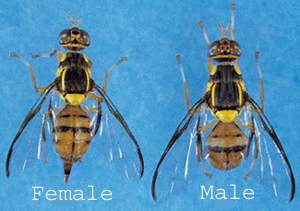
Oriental Fruit Fly Pest Profile

- Common Name:
Oriental Fruit Fly - Scientific Name:
Bactrocera dorsalis (Hendel). - Order and Family:
Diptera, Tephritidae
Description
The adult oriental fruit fly is somewhat larger than a housefly, about 8 mm in length. The body color is variable but generally bright yellow with a dark "T" shaped marking on the abdomen. The wings are clear. The female has a pointed slender ovipositor to deposit eggs under the skin of host fruit. Eggs are minute cylinders laid in batches. The maggots (larvae) are creamy-white, legless, and may attain a length of 10 mm inside host fruit.
History & Economic Importance
Oriental fruit fly has been established in Hawaii since 1946 where it is a major pest of agriculture, particularly on mangoes, avocados and papayas. Maggots have been found in over 125 kinds of fruit and vegetables in Hawaii alone. A great number of crops in California are threatened by the introduction of this pest, including pears, plums, cherries, peaches, apricots, figs, citrus, tomatoes and avocados. It has been estimated that the cost of not eradicating oriental fruit fly in California would range from $44 to $176 million in crop losses, additional pesticide use, and quarantine requirements. Oriental fruit fly has been introduced into California a number of times through the movement of infested fruits and vegetables into the state. Although infestations have occasionally been found in California, these have all been successfully eradicated.
Distribution
Oriental fruit fly is widespread through much of the mainland of Southern Asia and neighboring islands, including Sri Lanka and Taiwan. Distribution in the United States is restricted to the Hawaiian Islands.
Life Cycle
Females lay eggs in groups of three to 30 under the skin of host fruits; the female can lay more than 1,000 eggs in her lifetime. Time taken for development depends on the ambient temperature. Maggots tunnel through the fruit feeding on the pulp, shed their skins twice, and emerge through exit holes in approximately 10 days. The larvae drop from the fruit and burrow two three cm into the soil to pupate. In 10 to 12 days, adults emerge from these puparia. The newly emerged adult females need eight to 12 days to mature sexually prior to egg laying. Breeding is continuous, with several annual generations. Adults live 90 days on the average and feed on honeydew, decaying fruit, plant nectar, bird dung and other substances. The adult is a strong flyer, recorded to travel 30 miles in search of food and sites to lay eggs. This ability allows the fly to infest new areas very quickly.
Host and Damage
In excess of 230 fruits and vegetables have been attacked. Fruit that has been attacked may be unfit to eat as larvae tunnel through the flesh as they feed. Decay organisms enter, leaving the interior of the fruit a rotten mass.
Fact Sheets:
- Oriental Fruit Fly Fact Sheet
- Oriental Fruit Fly (Bactrocera dorsalis complex)
- Oriental Fruit Fly Host List
